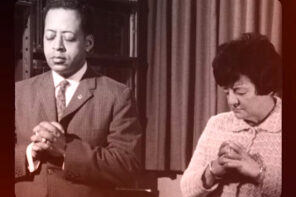Last week, Raw Story featured an unusual summer travel spot—The Occult Museum of Ed and Lorraine Warren. Although skeptics have dismissed the museum as “full of off-the-shelf Halloween junk, dolls and toys, books you could buy at any bookstore,” it’s an important case study in lived religion and the free exchange of ideas between pop culture and paranormal belief.
The Warrens (Ed passed in 2006) were infamous demonologists whose greatest “case files” have resulted in such “real life” horror films as The Amityville Horror, A Haunting in Connecticut, and The Conjuring, which featured “Annabelle,” a demonically-possessed doll acquired during the Warrens’ adventures that tourists can still visit at the museum.
The Warrens were Catholic and generally only showed up at the homes of Catholic families to offer their services. Their work demonstrated the often improvisational and messy logic of lived religion, combining Catholic ideas about demonology and the supernatural with a milieu of material gleaned from New Age metaphysics and popular culture.
When Dr. Steven Novella of the New England Skeptics Society visited the Warren’s museum, Ed warned the skeptics, “If you do touch anything, let me know because I’ll cleanse your aura by visualizing you in a Christ light.” Ed’s method of warding off evil energy was neither Catholic nor New Age, but made sense in its own context of popular demonology. Contemporary paranormal discourse rarely revolves around the question, “Is it true?” but rather, “Does it work?”
The museum’s prize, Annabelle, is a particularly interesting case study in the relationship between pop culture and paranormal folklore. According to legend, a nursing student received a Raggedy Ann doll from her mother in 1970. When the doll exhibited strange behavior, a medium revealed that the doll was possessed by a dead woman named “Annabelle Higgins.” The student and her roommate took compassion for the spirit and granted Annabelle permission to reside in the doll. However, when frightening incidents continued to occur, they contacted the Warrens, who declared that “Annabelle Higgins” was actually a demon.
Around the same time, a story emerged about “Robert,” a doll allegedly given to Robert Eugene Otto of Key West, Florida in 1906 by a Caribbean woman skilled in black magic. This doll—currently on exhibit in Key West’s Fort East Martello Museum and Gardens—allegedly moved by itself and exhibited other disturbing behavior.
Why did two stories of demonic dolls emerge in 1970? It may have something to do with the Twilight Zone episode “Living Doll,” which aired in 1963. In that episode, a mother (named Annabelle), gives her daughter a “Talky Tina” doll that proceeds to terrorize the girl’s stepfather before causing him to fall down the steps and die in an apparent accident. (Ed Warren warned that the last museum visitor who mocked Annabel died in motorcycle accident). The demonic doll trope jumped from pop culture to folklore and then back to pop culture. Robert—a demonic doll enchanted through Caribbean magic—is believed to be the inspiration for the “Child’s Play” films and Annabelle received a much creepier makeover in The Conjuring.
The idea of demonically-possessed dolls allows modern demonologists to find supernatural evil in the most banal and domestic of places. Haunted houses are, among things, private realms of enchantment in which a family has privileged access to supernatural forces. The lore of demonic dolls, regardless of its provenance, is a logical addition to this project.
Believers who make the trip this summer to see Annabelle in Lorraine Warren’s basement will get to access this uncanny blend of the domestic and otherworldly that contemporary demonology provides.




